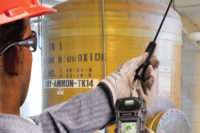One of the gases believed to contribute to the greenhouse effect and subsequent global temperature increase is carbon dioxide (CO2). The earth’s CO2 atmospheric level has steadily increased by more than 20 percent over the past 50 years, likely due to deforestation, population increase, industrialization, and the biggest overall contributor, fossil fuel combustion.
Electronics boom
Instrument processors and components change faster than ever, resulting in new products hitting the market at faster rates, offering even better features at lower prices. Initially, end users benefit positively from increasingly better prices and added features, but what of the environmental impact?
Not long ago, gas detectors had a 10-year+ economic life. Nowadays that service life is reduced to two to three years, as replacing instruments is more economical than repair or even sensor replacement. Less expensive components reduce gas detector costs significantly and, at the same time, enhanced safety regulations require more workers to wear gas detectors. Increased demand combined with shorter product life cycles not only results in increased production at component and instrument levels, but also in increased waste at the other end of the supply chain, with direct environmental impact. Higher manufacturing output also requires more transportation of components and instruments globally, consequently contributing to increased CO2 emissions. Although most electronic (e-waste) and chemical waste is recycled, significant waste still ends up in our environment, likely contributing to health and pollution problems.
Your choices matter
How can you contribute to limiting chemical/e-waste and CO2 emissions while still protecting your employees and increasing your operation’s profits?
Many products are available to meet your gas detection needs, but it’s worth considering that not all gas detectors share the same design and construction. The most obvious customer purchasing factors are price and features; however, factors usually less considered are long-term costs of ownership and environmental consequences.
Three simple steps
The following three easy steps are not new, save one more factor for your purchasing decision: environmental impact. These steps should assist you in making the right choices for your company and minimizing e-waste.
First, look for products that meet or exceed your specific application requirements. Second, look for manufacturers who strive to reduce e-waste by designing innovative, durable and long-lasting products. Finally, compare and select products that provide optimum balance as far as lowering your long-term cost of ownership, increasing performance and addressing environmental concerns.
Smart choices
Choose your purchases based upon instrument design that provides durability and long run time. The latest generation of ASIC-based (application-specific integrated circuit) sensors provide reliable gas concentration readings, long service life and faster response times, while requiring significantly lower amounts of calibration gas for daily bump tests or full calibrations.
Environmental impact
How do such features translate to environmental savings?
- Longer run times result in fewer charging cycles, preserving energy and reducing CO2 emissions.
- Fewer charging cycles also increase battery life, ultimately reducing battery waste.
- Longer-lasting sensors help to reduce environmental chemical waste.
- More durable products reduce the need for replacement instruments and spare parts, directly affecting manufacturing (CO2 emissions) and e-waste.
- If your gas detector’s overall service life increases, packaging material per detector per year is also reduced.
- Less required calibration gas per use results in reduced cylinder waste.
- Lowering instrument replacement frequency lessens CO2 emissions, reducing transportation needs per year per detector.
Think green
The steps listed here not only result in reducing environmental consequences; maintenance and labor costs are also lowered, directly affecting your budget. During economic downturns when everyone’s budget is under scrutiny, making conscious, positive decisions can truly make a difference.




